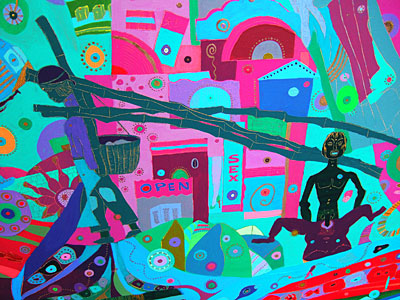100 Global Villagers are depicted in the painting THE WORLD – REALITY, and biographies have been written for each of them.
SAMPLE VILLAGER No. 13 – Enjoyment
from THE WORLD – REALITY, Panel B
Woman aged 50 from Shaanxi Province, China. Non-religious, lives off two dollars a day, is undernourished, illiterate, heterosexual and has been sexually abused.
Portrayed in THE WORLD – REALITY (Panel A, top left and Panel B, bottom left) and
Portrayed in THE WORLD – VISION (Panel B, bottom left)
REALITY
The Yellow River twists and turns like a metallic snake towards a hazy horizon of distant hills. When it changes course, the water churns round the bends, turning brown with silt, and continues relentlessly. Along its banks, a woman also moves forward continuously, though she cannot compete with the pace of the flow of water. She shuffles along in baggy trousers and her tattered apron flaps in the wind. Four thick bamboo poles are tied together, the front ends resting on her shoulders and the back ends on the ground four or five metres behind her. With her arms stretched out on either side, she bends under a huge crucifix. Straining and sweating under the weight, she focuses on her feet, oblivious of the bicycles passing her, piled high with gas bottles and sacks of salt. She is resigned to carrying her load and resolves to hold out to the bitter end. She has to transport the poles to the building site downstream. There is no alternative way of making ends meet.
VISION
As midday approaches, a group of barefooted men running along with wheelbarrows of coal shout at her to get out of the way. She does not hear them. Her feeble last minute attempt to swerve makes her fall on her side. The sun beats down intensely, the poles cut into her bleeding shoulders, and she is on the verge of complete collapse. One of the fishermen whose nets are suspended between the willow trees notices her stumble and rushes to her aid. Although her inner pride immediately rebels, she allows herself to be helped and bandaged. A group of ragged, barefoot children gather round her and gape. Usually, she would have pushed them away brusquely, but her ankle is twisted and she cannot move. Instead of dealing out verbal abuse, she speaks softly to them, explaining what has happened. She speaks comforting words to a reticent toddler with tear-stained cheeks who is frightened by the sight of blood. She is invited to stay while she recuperates, and the children delight in showing her the insects and flowers they have found. The fisherman is only too happy to tie the bamboo poles together behind his boat so that they float effortlessly downstream to the building site. He is going that way anyway. The woman learns to listen attentively, accept help graciously and to enjoy precious joyful moments with her new adopted family. In the course of time, she feels more invigorated than ever before, realizing that her own blinkered vision is the sole source of any obstacles she encounters on life’s path.
Questions
- What cross have you resigned yourself to carrying?
- In what way are you about to stumble?
- What if ‘stumbling’ is not a sign of weakness but an opportunity to assess why you have chosen this difficult path and whether it is appropriate for you to continue?
- To what extent does personal pride dictate your behaviour? Do you associate pain with failure?
- How often do you accept offers of help?
- What do you continue to do although you know intuitively that it is detrimental to your health?
- Can you cry with the ease and immediacy of a small child?
- Can you view a flower or an insect as a miracle? What can you be thankful for?
- Supposing that obstacles are simply areas of non-time (as proven in experiments involving obstacles and lasers) which help us to travel faster towards our goal. Can you see problems in the same light?
- What if everyone worldwide discarded their fear of ‘losing face’ and welcomed ‘failure’ as an opportunity to learn, instead of developing strategies of self-protection and defence?












